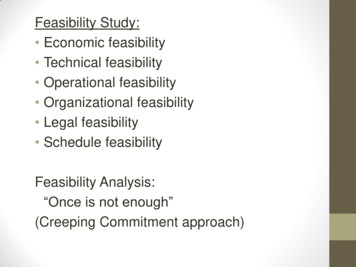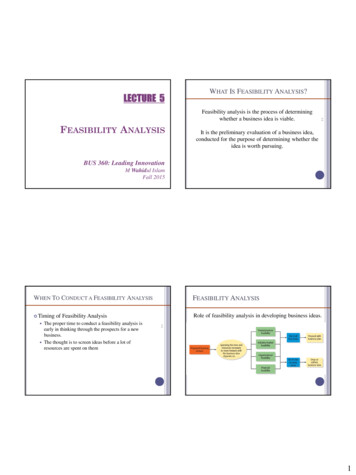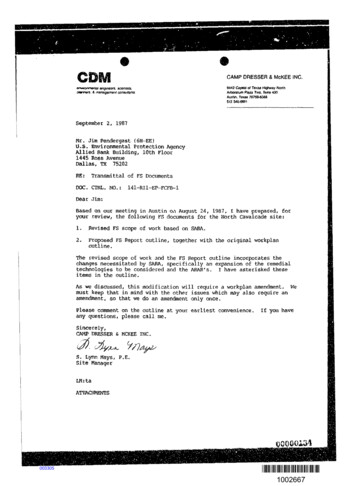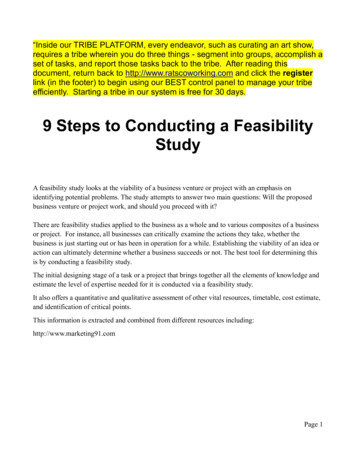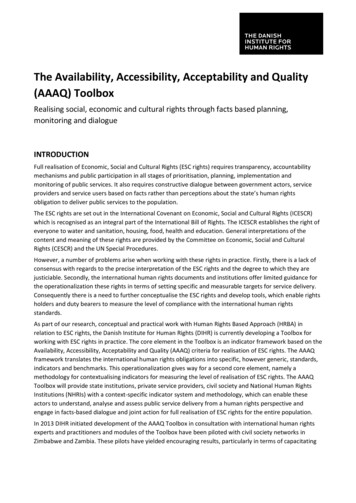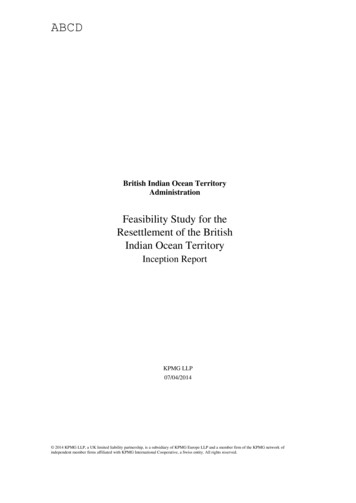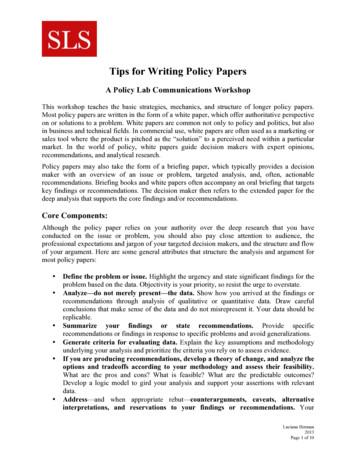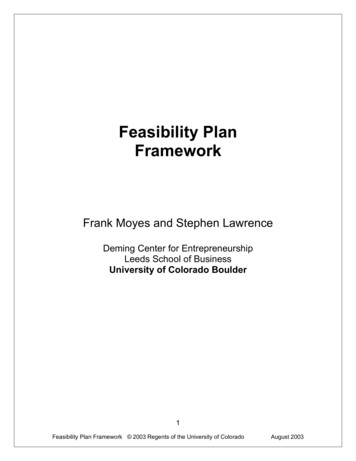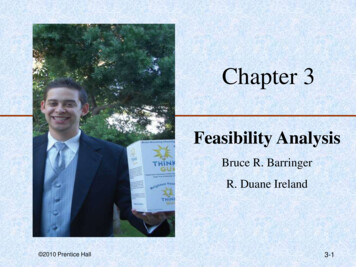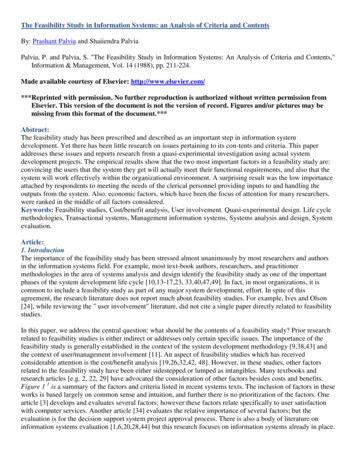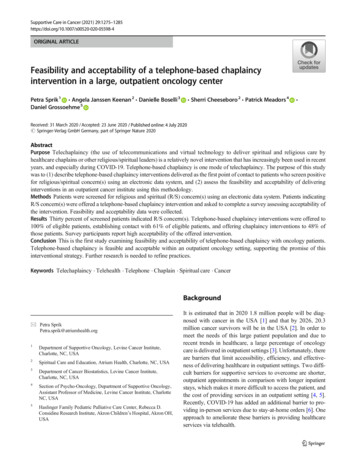
Transcription
Supportive Care in Cancer (2021) 5598-4ORIGINAL ARTICLEFeasibility and acceptability of a telephone-based chaplaincyintervention in a large, outpatient oncology centerPetra Sprik 1 & Angela Janssen Keenan 2 & Danielle Boselli 3Daniel Grossoehme 5&Sherri Cheeseboro 2 & Patrick Meadors 4&Received: 31 March 2020 / Accepted: 23 June 2020 / Published online: 4 July 2020# Springer-Verlag GmbH Germany, part of Springer Nature 2020AbstractPurpose Telechaplaincy (the use of telecommunications and virtual technology to deliver spiritual and religious care byhealthcare chaplains or other religious/spiritual leaders) is a relatively novel intervention that has increasingly been used in recentyears, and especially during COVID-19. Telephone-based chaplaincy is one mode of telechaplaincy. The purpose of this studywas to (1) describe telephone-based chaplaincy interventions delivered as the first point of contact to patients who screen positivefor religious/spiritual concern(s) using an electronic data system, and (2) assess the feasibility and acceptability of deliveringinterventions in an outpatient cancer institute using this methodology.Methods Patients were screened for religious and spiritual (R/S) concern(s) using an electronic data system. Patients indicatingR/S concern(s) were offered a telephone-based chaplaincy intervention and asked to complete a survey assessing acceptability ofthe intervention. Feasibility and acceptability data were collected.Results Thirty percent of screened patients indicated R/S concern(s). Telephone-based chaplaincy interventions were offered to100% of eligible patients, establishing contact with 61% of eligible patients, and offering chaplaincy interventions to 48% ofthose patients. Survey participants report high acceptability of the offered intervention.Conclusion This is the first study examining feasibility and acceptability of telephone-based chaplaincy with oncology patients.Telephone-based chaplaincy is feasible and acceptable within an outpatient oncology setting, supporting the promise of thisinterventional strategy. Further research is needed to refine practices.Keywords Telechaplaincy . Telehealth . Telephone . Chaplain . Spiritual care . CancerBackground* Petra SprikPetra.sprik@atriumhealth.org1Department of Supportive Oncology, Levine Cancer Institute,Charlotte, NC, USA2Spiritual Care and Education, Atrium Health, Charlotte, NC, USA3Department of Cancer Biostatistics, Levine Cancer Institute,Charlotte, NC, USA4Section of Psycho-Oncology, Department of Supportive Oncology,Assistant Professor of Medicine, Levine Cancer Institute, CharlotteNC, USA5Haslinger Family Pediatric Palliative Care Center, Rebecca D.Considine Research Institute, Akron Children’s Hospital, Akron OH,USAIt is estimated that in 2020 1.8 million people will be diagnosed with cancer in the USA [1] and that by 2026, 20.3million cancer survivors will be in the USA [2]. In order tomeet the needs of this large patient population and due torecent trends in healthcare, a large percentage of oncologycare is delivered in outpatient settings [3]. Unfortunately, thereare barriers that limit accessibility, efficiency, and effectiveness of delivering healthcare in outpatient settings. Two difficult barriers for supportive services to overcome are shorter,outpatient appointments in comparison with longer inpatientstays, which makes it more difficult to access the patient, andthe cost of providing services in an outpatient setting [4, 5].Recently, COVID-19 has added an additional barrier to providing in-person services due to stay-at-home orders [6]. Oneapproach to ameliorate these barriers is providing healthcareservices via telehealth.
1276The World Health Organization defines telehealth as “theuse of telecommunications and virtual technology to deliverhealthcare outside of traditional healthcare facilities” [7].Telehealth modalities can include telephone, smartphone applications, live videoconferencing, and Internet interventions,which are delivered synchronously or asynchronously [8].The terms “telehealth” and “telemedicine” are often used interchangeably; however, telehealth can include clinical andnon-clinical services, where telemedicine only includes clinical services [7, 9].Telehealth has been used since the early 1900s, grew exponentially in the 1970s with the growth of portable technology, is currently used by a wide variety of healthcare specialties, and is predicted to expand in its utilization [8–10]. At the2017 annual meeting of the Association of CommunityCancer Centers, Lindsay Conway predicted that by 2020, virtual consultation would increase by 60% among cancer carefacilities [11]. COVID-19 drastically increased implementation of telehealth in the USA, with predicted long-term utilization of these modalities after the pandemic [6, 12].Studies examining the impact of telehealth interventionshave shown a variety of telehealth services to be feasibleand acceptable, producing comparable outcomes to inperson care [9, 13–17]. However, not all aspects of telehealthservices are acceptable to patients. A review by Cox and colleagues revealed a more nuanced impression of the acceptability of telehealth services by cancer survivors [4]. Cancer survivors reported the following benefits of telehealth services:enhanced management of one’s care, anonymous space to talkabout personal issues, increased time to address patient needs,convenience, and a sense of constant access and being monitored [4]. Reported negative perceptions of telehealth servicesincluded feeling like the service was an additional, burdensome responsibility, the format feeling impersonal, and limited technological literacy [4]. Similarly, a study on telehealthgenetic counseling showed telehealth to be acceptable, exceptfor some tasks which were difficult when performed distally[17]. When viewed together, these studies suggest thattelehealth can be a feasible and acceptable way to meet patient’s needs, but that telehealth may be more acceptable forcertain interventions. More study is needed to understand thenuances of how to best deliver telehealth services.Chaplaincy is one healthcare service that has more recentlysought to refine its telehealth practices. Healthcare chaplainsare individuals who work or volunteer within healthcare contexts to provide spiritual, religious, and emotional support topatients, caregivers, and staff [18]. Within inpatient settings,chaplaincy departments are often too small to meet all patients’ spiritual, religious, and emotional needs [19]; the sameis often true in outpatient clinics, with the added challenge ofshorter appointments to meet patients. “Telechaplaincy,” theuse of telecommunications and virtual technology (which caninclude but is not limited to, telephone, smartphoneSupport Care Cancer (2021) 29:1275–1285applications, live videoconferencing and internet interventions) to deliver spiritual and religious care by healthcarechaplains or other religious/spiritual leaders, may serve as apromising delivery modality to reduce these barriers.Forms of telechaplaincy have been used since the mid1900s, with more formalized programs being developed inthe early 2000s [20–23]. Recent studies have shown thattelechaplaincy interventions are feasible and acceptable withcaregivers of seriously ill patients, parents of children withcystic fibrosis, advanced illness/palliative care military veterans, and laypeople [21, 24–27]. Caregivers of seriously illpatients claimed that a telephone-based chaplaincy intervention helped them reflect and process and that they appreciatedthe anonymity of the phone [24]. Military veterans preferredan interdisciplinary telehealth program which included chaplaincy to similar in-person care [21]. Existing studies reportpositive outcomes of telephone-based chaplaincy interventions, including reduced levels of spiritual struggle and enhanced spiritual well-being [25, 26]. It appears thattelechaplaincy is a potentially efficacious method for providing chaplaincy in an outpatient setting, with most researchbeing done on telephone-based chaplaincy interventions.However, there are gaps in understanding the feasibility,acceptability, and outcomes of telechaplaincy. To date, research is limited to telechaplaincy interventions delivered asscheduled interventions. To our knowledge, no studies existon the feasibility and acceptability of telechaplaincy interventions where the intervention is delivered as the first point ofcontact. Additionally, only one study examines telephonebased chaplaincy with outpatient oncology patients, and itdoes not address feasibility and acceptability [27]. Chaplainsmay also experience additional barriers to deliveringtelechaplaincy. A previous study found that patients may associate chaplains with death and fear a visit from the chaplain[28]. Additionally, physical presence is central to chaplaincyinterventions [28, 29]. Little is known about how these variables affect the acceptability of telechaplaincy.The purpose of this study was to describe a telephonebased chaplaincy intervention delivered as the first point ofcontact and assess the feasibility and acceptability of delivering interventions in an outpatient cancer institute using thismethodology.MethodsParticipantsThis study was conducted at headquarters of an academic,hybrid, multi-site, community-based cancer institute in theSoutheastern United States. The study was approved by theinstitutional review board (IRB# 01-19-36E). Participantswere eligible if they were over the age of 18, English-
Support Care Cancer (2021) 29:1275–1285speaking, and screened positive for religious or spiritual (R/S)concern(s) using an electronic data system. The use of theelectronic data system to direct services was approved by theinstitutional review board prior to this study and permissionextended to this study (IRB# 04-18-09E). Participants may ormay not have had previous interaction with the chaplain byphone or in-person.ProcedureAs standard clinical practice at the cancer institute, fromMarch 18, 2019, to April 26, 2019, all patients consulted insurgical oncology, medical oncology, supportive oncology, orradiation oncology simulation were asked by a clinic staffmember to complete a distress screening assessment on a tablet prior to their appointment. Screening questions includedpsychological, financial, social, and religious/spiritual (R/S)queries and were used to generate referrals to supportive careservices, including chaplaincy. Two questions evaluated R/Sconcern: (1) Do you have spiritual or religious concerns? (response yes or no) and (2) Select any of the followingemotional/spiritual concerns you are experiencing: struggleto find meaning/ hope in life, doubts about your faith, concernfor family, isolation, shame/guilt, fear of death (answers wereeligible for multi-selection). Each variable correlates with oneor more of Galek and colleague’s seven spiritual need constructs [30]. Any patient who indicated one or more R/S concerns was referred to a chaplain. This procedure was previously approved by the IRB and implemented as standard ofcare.Prior to this study, as part of clinical practice, chaplainsreached out to patients who screened positive for R/S concern(s) either by telephone or in-person. For the purposes ofthis study, all visits were conducted by telephone using asystematized procedure in order to assess the feasibility andacceptability of this modality. Two chaplains delivered interventions; one was a board-certified chaplain and one pursuingboard certification. An online random number generator determined which chaplain would provide the intervention forthe first listed patient, with subsequent alternating assignment.Prior to delivering the intervention, the chaplain reviewedthe patient chart to asses medical condition and previous interaction with supportive services, in order to more sensitivelyengage in the conversation. The intervention was a semistructured phone call using a script, which was based on previous chaplaincy interactions, but standardized for study use(see Appendix 1). The intervention aimed to introduce thepatient to the chaplain, address the indicated R/S concern(s)from the screener, address any additional R/S concerns identified on the phone call, and establish follow-up visits if appropriate. Due to limitations in the chaplains’ available clinical hours, only one phone call was made to each person whoscreened positive for R/S concern(s), leaving a voicemail if1277possible/permissible when contact was not made. The intervention was delivered four to 12 days after the initial assessment, based on how quickly the referral report could be generated and chaplains’ availability to make the calls duringclinical hours.At the conclusion of the intervention, the chaplain requested permission to email the patient an anonymous survey analyzing acceptability of the intervention. If the patient agreed, asurvey was sent via email within 48 h using an automatedemail system, which sent the survey up to three times if notcompleted. Consent was explained at the beginning of thesurvey, and completion of the survey was considered consent,as deemed by the IRB.MeasuresDemographicsDemographics including age, gender, and race were obtainedfrom the distress screener on all patients who completed theassessment (including those who screened positive and negative for R/S concerns). Patient characteristics, including age,gender, race, religion (eligible for multi-select), and whethercancer diagnosis had been received at time of phone call, wereobtained from completed surveys.FeasibilityCollected feasibility data included (1) the percentage of patients eligible for an intervention who received a phone callfrom a chaplain, (2) the percentage of contacted patients whotalked with a chaplain on the phone, and (3) the percentage ofpatients who talked with a chaplain on the phone who received a R/S intervention.For the first and second feasibility data points, chaplainsrecorded whether they were able to talk with the patient onthe phone, left a voicemail, delivered a message to family,or received a call back. For the third feasibility data point,chaplains determined whether they had delivered an R/Sintervention by phone based on criteria related to whetherthe call relied upon chaplain training and expertise (seeAppendix 2).AcceptabilityAcceptability data was obtained from surveys completed byparticipants who received an intervention and agreed to besent the survey. Survey questions were Likert-scale questions,adapted from previous chaplaincy patient satisfaction and effectiveness surveys [30–34].
1278Support Care Cancer (2021) 29:1275–1285Intervention descriptionTo understand the patient’s perception of the intervention,surveys included questions on the patient’s perception of thelength and subject matter of the intervention.Descriptive statistics were used to summarize survey responses to assess feasibility and acceptability of the intervention. All analyses were conducted using SAS 9.4 (SASInstitute, Cary, NC).Statistical proceduresResultsCharacteristics of all subjects completing the distress screening and the subset completing the survey were summarizedwith descriptive statistics. To understand the representativeness of subjects offered an intervention in the context of thisstudy to the epidemiology of the cancer institute and the representativeness of subjects completing a survey of those eligible for a intervention, characteristics were compared withFisher’s exact and rank-sum tests (where appropriate) betweenthe following subsets of subjects, respectively:Demographics(a) Subjects indicating at least one R/S concern on the distress screening v. subjects not indicating an R/S concernon the distress screening(b) Subjects completing the survey versus subjects indicating at least one R/S concern on the distress screening.A total of 711 unique patients completed the distress screening, of whom 30% indicated at least one R/S concern and wereeligible for the intervention. Of those who talked to a chaplainon the phone, 33% completed the survey (see Fig. 1).Patient characteristics of sub-groups are shown in Table 1.Subjects indicating at least one R/S concern were younger(p .021) than those not indicating R/S concern(s), but evidence did not suggest distributional differences in gender(p .173) or race (p .160) between the subsets.Additionally, no distributional differences in age(p .817), gender (p .999), or race (p .531) were detectedbetween participants indicating at least one R/S concern andsurvey respondents.Fig. 1 Consort statement (createdusing Microsoft Word)Patients screenedfor R/S concernN 711Contacted patientswho talked tochaplain on phoneN 124Patients whoagreed to be sentthe surveyN 84Patients whocompleted thesurveyN 41Patients indicatingR/S concernN 212Patients notindicating R/SconcernN 499Contacted patientswho did not talk tochaplain on phoneN 80Non-Englishspeaking patientsnot contactedN 8Patients who did notagree to be sent thesurveyN 40Patients who did notcomplete the surveyN 43
Support Care Cancer (2021) 29:1275–1285Table 11279Patient characteristics of study sub-groupsVariableAge at assessmentPatients indicating noR/S concern (n 499)Patients indicatingR/S concern(s) (n 212)Survey respondents (n 41)Median [min, max]61 [18, 90]Frequency (%)Median [min, max]57.5 [19, 91]Frequency (%)Median [min, max]57 [27, 74]Frequency (%)308 (62)190 (38)0 (0)1 (0)143 (67)69 (33)0 (0)0 (0)26 (63)13 (32)1 (2)1 (2)2 (0)7 (1)112 (22)365 (73)13 (3)3 (1)5 (2)36 (17)149 (70)19 (9)0 (0)2 (5)5 (12)30 (73)4 (10)GenderFemaleMaleUnknown/prefer not to answerMissingRaceAmerican Indian or Alaska NativeAsianBlack or African AmericanWhiteOther, unknown or prefer not to answerReligion (multi-select available)AgnosticChristian (non-denominational)Christian (Protestant)Christian (Catholic)HinduJewishNoneSpiritual but not religiousCancer diagnosis received at time of callYesNoMissingNot captured in assessment1 (2)14 (34)13 (32)5 (12)1 (2)2 (5)1 (2)6 (15)Not captured in assessment32 (78)8 (20)1 (2)Note: Percentages do not sum to 100% for prompts designed for multi-select and due to roundingFeasibilityA total of 208 participants were eligible to receive an intervention; 100% received a phone call from a chaplain. Chaplainsmade most phone calls within pre-planned time blocks.Seldomly, chaplains rearranged clinical responsibilities to contact patients when the patient was not at medical appointments.Of the 204 patients contacted, 61% of patients talked to achaplain on the phone, either answering the first call (n 118),answering the first call and rescheduling a second call due tobad timing (n 2), or calling the chaplain back after an initialvoicemail (n 4). If the subject was unable to talk on thephone at time of contact, the reason was obtained conversationally from family answering the phone in lieu of the patientor by the patient on a later call; reasons included feeling toosick to answer the phone, being at a medical appointment,having a medical reason they are unable to talk or hear onthe phone (such as a tracheostomy or deafness), not havingenough minutes programmed on their phone, being busy, orfamily denying permission to talk to the patient.Chaplains spoke to 124 patients on the phone, delivering R/S interventions to 48% (n 60). In cases where chaplains didnot deliver R/S interventions, they had supportive conversations that did not require chaplain expertise, had patients denyR/S concern(s), had patients refuse the conversation, or wereunable to deepen the conversation.AcceptabilityAcceptability with the telephone-based chaplaincy intervention was high among survey respondents. Participants’ positively ranked the chaplain’s ability to deliver service components over the phone. Over 90% of surveyed participants were“very satisfied” with the chaplain’s ability to listen to them,and to make them feel comfortable on the phone. Over halfwere “very satisfied” with the chaplain’s ability to pray, help
1280Support Care Cancer (2021) 29:1275–1285them tap into their inner strengths and resources, and overcome their fears and concerns on the phone (see Fig. 2).The majority of survey participants found various aspectsof the intervention to be acceptable, indicating they were“very much” satisfied with the length of the phone call, thechaplain’s conveyed care, and response to spiritual and emotional concerns. The majority of participants were “not at all”scared by receiving a phone call from a chaplain, with 24%indicated some level of fear (see Fig. 3).Only five participants indicated “not at all” or “slightly” toquestions pertaining to acceptability of the intervention. Thesepeople varied by gender, age, race, and the topics that theydiscussed on the phone with the chaplain. Most spent less than10 min on the phone with the chaplain (n 4), with one spending between 11 and 30 min. They indicated moderate or highsatisfaction to most other questions.After having experienced the telephone-based chaplaincy intervention, survey participants were asked how they would prefer to receive chaplain interventions from a list of options available for multi-select. The most commonly indicated mediumwas the telephone (n 30). The next most commonly indicatedwere in-person at a doctor’s appointment (n 11), in-person byscheduling a chaplain visit (n 10), and by text (n 7).Telephone-based chaplaincy interventionAccording to survey respondents, the majority of telephoneconversations lasted less than 30 min; with categorical surveyoptions being less than 10 min (n 12), between 11 and30 min (n 19), between 31 min and an hour (n 2), andFig. 2 Acceptability of chaplain’sabilities of delivering telephonebased chaplaincy. Note:Percentages may not sum to100% due to rounding (createdusing Microsoft Excel)more than an hour (n 1). Seven people did not rememberthe length of the conversation.Survey respondents also identified their perception of thesubject matter of the intervention. Frequencies of addressed R/S concern(s) were similar to frequencies of experienced R/Sconcern(s) among the surveyed population. The most frequentlyaddressed subject matter was concern for family, fear of death,and spiritual/religious concern. However, more participants reported talking to a chaplain about religious and spiritual subjectmatter and isolation than reported experiencing those concerns.A few patients reported experiencing concern for family, shame/guilt, and fear of death that did not report talking about those R/Sconcerns in the intervention (see Table 2).DiscussionThese results suggest that screening for R/S needs using anelectronic data system and using phone calls as the first pointof contact for offering interventions is feasible at an outpatientcancer institute. Two chaplains who were working part-timewere able to complete all referrals in a timely manner, establishing contact with 124 patients, and delivering chaplaincyinterventions to 60 patients over the course of 6 weeks. Whilerearranging clinical time was required, this need was minimal.Findings also suggest that chaplaincy delivered by phoneas the first contact is acceptable to patients seen in an outpatient oncology clinic, with surveyed patients reporting positiveresponses about the chaplain’s abilities on the phone, andvarious aspects of the service offered. These findings areHow satisfied were you with the chaplain's ability(on the phone) to provide a referral for other helpyou needed?2% 5%How satisfied were you with the chaplain's ability(on the phone) to help you overcome your fears orconcerns?5%How satisfied were you with the chaplain's ability(on the phone) to help you tap into your innerstrengths and resources?How satisfied were you with the chaplain's ability topray with you on the phone?12%54%17%2%29%56%27%59%How satisfied were you with the chaplain's ability tomake you feel comfortable on the phone?39%90%7%How satisfied were you with the chaplain's ability toreally listen to you on the phone?93%5%0%46%46%Moderately2%10% 20% 30% 40% 50% 60% 70% 80% 90% 100%% of Survey ParticipantsSlightly2%Very SatisfiedDoes not apply
Support Care Cancer (2021) 29:1275–1285Fig. 3 Acceptability oftelephone-based chaplaincy intervention. Note: Percentages maynot sum to 100% due to missingresponses (2%) being excludedfrom charts and due to rounding1281Did receiving a phone call with the chaplain scareyou?15%71%7% 2% 5%Did the phone call with the chaplain provide enoughprivacy for you to feel comfortable talking?2%2%88%5%On the phone, did the chaplain help you use yourfaith, beliefs or values to cope?5% 2%12%63%17%On the phone did the chaplain seem to care aboutyou?98%2%Did the chaplain spend enough time with you on thephone?93%2%2%How well did the chaplain respond to your spiritualand emotional concerns on the phone?2%0%83%5%10%10% 20% 30% 40% 50% 60% 70% 80% 90% 100%% of Survey ParticipantsNot at allSlightlysimilar to other telechaplaincy acceptability studies, whichreported telechaplaincy as an acceptable intervention amongvarious populations [20–23]. The intervention also has similaracceptability to a study examining acceptability of inpatientchaplain interventions [30].Findings also suggest that the phone may be a preferredmode of contact for outpatient oncology patients. Survey respondents most often indicated that phone was their preferredmethod of receiving chaplaincy. This response is biased by thetelephone being the mode by which they recently received chaplaincy services; however, it shows acceptability of the servicedelivered and the potential for this being a preferred method.Nonetheless, findings also suggest that there are ways toimprove this intervention. This intervention differed from previously studied interventions in that patients did not enroll in atelechaplaincy program prior to receiving contact from thechaplain by telephone. Approximately 25% of patients wereat least “slightly” scared by receiving a phone call from thechaplain, despite being informed on the screener that they maybe contacted by a member of the supportive oncology team,and the chaplain introducing themselves as “from the spiritualcare department” rather than as a chaplain. While patient’sfear did not deter higher acceptability scores with the intervention overall, it does suggest that fear of receiving a callModeratelyVery MuchDoes not applyfrom the chaplain is a necessary barrier to address in order todeliver telephone interventions in a less distressing way.This intervention was also different from previoustelechaplaincy interventions in that it did not have an anticipated length of conversations. Surveyed patients reportedshort phone conversation lengths, with most lasting less than30 min. This was much shorter than other interventions whichoffered multiple, hour-long conversations [24, 25].Nonetheless, patients found the care they received acceptable.This suggests that telephone-based chaplaincy might be atimely way to establish contact and assess for deeper needsthat may require further follow-up. However, short conversations likely do not provide enough time to deeply assess oraddress patient’s R/S concern(s), as is shown by varied responses to the question “on the phone, did the chaplain helpyou use your faith, beliefs or values to cope?” In comparison,longer interventions, like the one delivered by Betz and colleagues, showed evidence that spiritual struggle was addressed in a longer, multi-meeting telephone intervention[25]. Future studies should address the ideal timing and lengthof telechaplaincy interventions.Findings also suggest that a wide range of R/S concernscan be addressed via telephone. Concern for family, fear ofdeath and R/S concerns were the most commonly identified
1282Support Care Cancer (2021) 29:1275–1285Table 2 Survey respondents report of R/S concern(s) and telephoneintervention subject matter (n 41)ConclusionR/S concern (multiselect available)R/S concern(s)experienced in last7 days, frequency (%)R/S concern(s)discussed in telephoneintervention,frequency (%)Concern for family24 (59)23 (56)Fear of deathReligious/spiritualconcernsIsolationStruggle to findmeaning/hopeShame/guiltDoubts aboutyour faithNone of listedconcernsDo not remember12 (29)4 (10)9 (22)9 (22)4 (10)4 (10)6 (15)4 (10)3 (7)2 (5)2 (5)2 (5)This study adds to the emerging voice that supportstelephone-based chaplaincy as an acceptable and feasible methodology. Especially in oncology, wherehealthcare is increasingly being delivered in outpatientsettings, telechaplaincy offers a promising way to overcome the difficulty of addressing patient’s R/S concernswithin the short time span of patient appointments. Thismethodology is also relevant due to COVID-19. Astelechaplaincy practice is refined through research, itmay prove to be an essential tool in addressing oncology patients’ holistic health.11 (27)5 (12)N/A3 (7)Note: Percentages do not sum to 100% as prompts were eligible for multiselectsubject matter by patients, though patients indicated high acceptability with conversations covering all indicated R/S concerns. At the same time, there were several times where thechaplain did not address the patient’s reported R/S concern,including concern for family, shame/guilt, and fear of death.This may be because of the sensitive nature of the subjectmatter, chaplain skill, or the limitations of the telephone.More study is needed to determine which R/S concerns arebest addressed by telehealth versus in-person chaplaincy.Limitations and strengthsThere were several limitations of this study. Small sample sizelimits the generalizability of the study, and ability to examinecorrelations. Participants came from a single site, where the R/S demographic is significantly different from national means,which also limits generalizability. Resource limitations permitted onl
stays, which makes it more difficult to access the patient, and the cost of providing services in an outpatient setting [4, 5]. Recently, COVID-19 has added an additional barrier to pro-viding in-person services due to stay-at-home orders [6]. One approach to ameliorate these barriers is providing healthcare services via telehealth. * Petra Sprik
